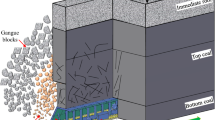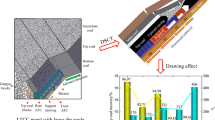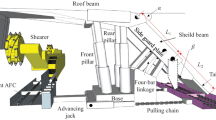Abstract
Due to the unbalanced top coal drawing process, the recovery ratio is low, and the equipment stability is poor in the longwall top coal caving mining (LTCC) with an inclined seam. Aimed at these problems, this paper proposes the dynamic group caving method (DGCM). The basic procedure is that when the drawn volume of top coal from a support reaches about half, the next support begins drawing top coal, and the drawing process between the two supports is half done. Taking the panel no. 8103 in Beixinyao mine as the research object, the characteristics of drawing body shape, particle movement trace, and variation of recovery ratio are investigated by using Particle Flow Code. Furthermore, the effect of mining-caving ratio on the top coal drawing law under DGCM is revealed by the simulation results, and compared with the single-opening sequence caving method (SSCM) and the double-openings sequence caving method, advantages of DGCM are determined in inclined seams. The results show that the drawing body can be divided into the left and the right under DGCM. Specifically, the drawn top coal particles in the left are from the upper part of this support, that in the right are from the lower part of next support, which verifies the correctness of the theoretical analysis. The characteristics of the drawing body shape are more significant when the mining-caving ratio is relatively small. In addition, with increasing mining-caving ratio, the recovery ratio of the panel both increases gradually under DGCM and SSCM. When the mining-caving ratio is less than 1:1, the recovery ratio of DGCM is obviously higher than that of SSCM, indicating that DGCM can greatly improve the recovery ratio. While when the mining-caving ratio is larger than 1:1, the recovery ratio of two caving methods is basically equal; however, the advancing time is significantly shortened under DGCM. This study are of great significance to realize high efficiency and precise caving in LTCC with an inclined seam.














Similar content being viewed by others
References
Wang JC, Zhang JW, Li ZL (2016) A new research system for caving mechanism analysis and its application to sublevel top-coal caving mining. Int J Rock Mech Min Sci 88:273–285
Wang JC, Zhang JW (2015) BBR study of top-coal drawing law in longwall top-coal caving mining. J China Coal Soc 40:487–493
Song ZY, Konietzky H (2019) A particle-based numerical investigation on longwall top coal caving mining. Arab J Geosci 12:556
Song ZY, Konietzky H, Herbst M (2020) Drawing mechanism of fractured top coal in longwall top coal caving Int J Rock Mech Min Sci 130
Zhang JW, Wang JC, Wei WJ, Chen Y, Song ZY (2018) Experimental and numerical investigation on coal drawing from thick steep seam with longwall top coal caving mining. Arab J Geosci 11:96
Khanal M, Elmouttie M, Adhikary D (2017) Effects of particle shapes to achieve angle of repose and force displacement behaviour on granular assembly. Adv Powder Technol 28:1972–1976
Wang JC, Wei WJ, Zhang JW (2019) Effect of the size distribution of granular top coal on the drawing mechanism in LTCC. Granul Matter 21:70
Wei WJ, Song ZY, Zhang JW (2018) Theoretical equation of initial top-coal boundary in longwall top-coal caving mining. Int J Min Mineral Eng 9:157–176
Wang JA, Jiao JL, Cheng WD, Yun DF, Xie JW, Shangguan KF (2015) Roles of arc segment in controlling the support stability in longwall fully mechanized top coal caving mining face of steeply inclined coal seam. J China Coal Soc 40:2361–2369
Mishra B, Nie D (2013) Experimental investigation of the effect of change in the control modes on the post-failure behavior of coal and coal measures rock. Int J Rock Mech Min Sci 60:363–369
Verma P, Mishra B (2015) An experimental investigation of the creep behavior of an underground coal mine roof with shale formation. Int J Coal Geol 137:55–65
Li ZL, He XQ, Dou LM, Song DZ (2018) Comparison of rockburst occurrence during extraction of thick coal seams using top-coal caving versus slicing mining methods. Can Geotech J 55:1433–1450
Yasitli NE, Unver B (2005) 3D numerical modeling of longwall mining with top-coal caving. Int J Rock Mech Min Sci 42:219–235
Unver B, Yasitli NE (2006) Modelling of strata movement with a special reference to caving mechanism in thick seam coal mining. Int J Coal Geol 66:227–252
Vakili A, Hebblewhite BK (2010) A new cavability assessment criterion for longwall top-coal caving. Int J Rock Mech Min Sci 47:1317–1329
Le TD, Oh J, Hebblewhite B, Zhang CG, Mitra R (2018) A discontinuum modelling approach for investigation of longwall top coal caving mechanisms. Int J Rock Mech Min Sci 106:84–95
Le TD, Zhang CG, Oh J, Mitra R, Hebblewhite B (2019) A new cavability assessment for longwall top coal caving from discontinuum numerical analysis. Int J Rock Mech Min Sci 115:11–20
Basarir H, Oge IF, Aydin O (2015) Prediction of the stresses around main and tail gates during top coal caving by 3D numerical analysis. Int J Rock Mech Min Sci 76:88–97
Likar J, Medved M, Lenart M, Mayer J, Malenković V, Jeromel G, Dervarič E (2012) Analysis of geomechanical changes in hanging wall caused by longwall multi top caving in coal mining. J Min Sci 48:135–145
Jeromel G, Medved M, Likar J (2010) An analysis of the geomechanical processes in coal mining using the Velenje mining method. Acta Geotech Slov 7:30–45
Kumar R, Singh AK, Mishra AK, Singh R (2015) Underground mining of thick coal seams. Int J Min Sci Technol 25:885–896
Kumar R, Mishra AK, Singh AK, Singh AK, Ram S, Singh R (2016) Depillaring of total thickness of a thick coal seam in single lift using cable bolts: a case study. Int J Min Sci Technol 26:223–233
Wang JC, Zhang JW, Chen Y (2016) Research on technology of improving top-coal recovery in longwall top-coal caving mining based on BBR system. Journal of Mining Science and Technology 1:44–54
Sun LH, Ji HG, Cai ZY, Zhang B, Yang BS (2016) Top-coal caving process and movement characters of fully mechanized caving face in steeply dipping thick seam. Journal of Mining and Safety Engineering 33:208–213
Wang JC, Wei WJ, Zhang JW, Xie F (2017) Stability analysis of support around the longwall top-coal caving mining in steeply thick coal seam. J China Coal Soc 42:2783–2791
Melo F, Vivanco F, Fuentes C, Apablaza V (2007) On drawbody shapes: from Bergmark–Roos to kinematic models. Int J Rock Mech Min Sci 44:77–86
Wang JC, Wei WJ, Zhang JW (2020) Theoretical description of drawing body shape in an inclined seam with longwall top coal caving mining. Int J Coal Sci Technol 7:182–195
Wang JC, Wei WJ, Zhang JW, Mishra B, Li A (2020) Numerical investigation on the caving mechanism with different standard deviations of top coal block size in LTCC. Int J Min Sci Technol
Zhang JW, Wang JC, Wei WJ, Li LH (2019) Experimental investigation on the effect of size distribution on the flow characteristics of loose top coal. J China Coal Soc 44: 985–994
Funding
This work was supported by the National Key R&D Plan of China [Grant No. 2018YFC0604501] and the Natural Science Foundation of China [Grant Nos. 51974320, 51934008, 51904305]. The corresponding author would also give special thanks to China Scholarship Council (Grant No. 201906430010).
Author information
Authors and Affiliations
Corresponding author
Ethics declarations
Conflict of Interest
The authors declare that they have no conflict of interest.
Additional information
Publisher’s Note
Springer Nature remains neutral with regard to jurisdictional claims in published maps and institutional affiliations.
Rights and permissions
About this article
Cite this article
Yang, S., Wei, W. & Zhang, J. Top Coal Movement Law of Dynamic Group Caving Method in LTCC with an Inclined Seam. Mining, Metallurgy & Exploration 37, 1545–1555 (2020). https://doi.org/10.1007/s42461-020-00254-1
Received:
Accepted:
Published:
Issue Date:
DOI: https://doi.org/10.1007/s42461-020-00254-1




